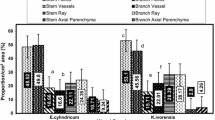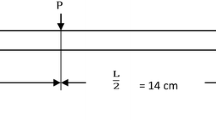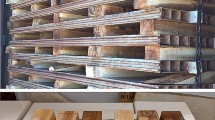Abstract
Non-durable timbers, employed as substitutes for the over-exploited traditional species for structural applications, are chemically-treated to extend their service-lives. However, strength properties of treated woods are barely investigated, particularly for tropical species. Some physico-mechanical characteristics (e.g. compressive strength, static bending and specific gravity) of three commonly-preserved, structural timbers (Terminalia superba, Antiaris toxicaria and Celtis mildbraedii) were examined after treatment with an organic preservative (Erythrophleum suaveolens seed extract) and an inorganic type (Pyrinex 48EC) at 0.5 and 1 % concentrations. Treatment was through non-pressure (i.e., steeping) and pressure methods. Specific gravities (SGs) of the stakes (air-dried to 12–14 % mc) increased after impregnation. Chemical retention and SGs were greater for pressure-treated stakes at 1 % than by steeping at 0.5 %. Differences in SG between non-pressure treated stakes at 0.5 and 1 % were not significant (p < 0.05). The physico-mechanical properties were affected by the preservative type, concentration, retention and the treatment process. Strength properties of treated stakes rank in this decreasing order for the hardwoods: C. mildbraedii > T. superba > A. toxicaria. Compression and static bending strengths for control were greater than the treated. Stakes pressure-treated at greater retentions and concentration (i.e., 1 %) lost greater strength than those, which went through steeping at lower retention and concentration (i.e., 0.5 %). This implies that limitations in strength characteristics of chemically-treated wood need be properly addressed by wood and engineering industries in the design of standards for timber in construction.





Similar content being viewed by others
References
Anonymous (1986a) Wood preservation manual. Food and Agriculture Organization (FAO). Forestry paper no. 76
Anonymous (1986b) Methods of testing small clear specimens of timber. British Standard Institution—BS 373: 1957
Anonymous (1998) Properties and use of wood, composites, and fibre products. Effects of waterborne preservative treatment on wood strength. TECHLINE. United States Department of Agriculture, Forest Service, Forest Products Laboratory, Issued 02/98, V1-6; http://www.fpl.fs.fed.us/. Accessed 22 July 2011
Anonymous (2005) Treated wood. The New Florida Home, Florida Wood Council, Mount Dora
Anonymous (2006) Materials safety data, Pyrinex 48EC. Identification of the Substance/Preparation and of the Company/Undertaking. Makhteshim Chemical Works Ltd., Israel
Anonymous (2008) The tropical timbers of Ghana. Ghana Forestry Commission, Timber industry development division (TIDD), Forest Services Division, Wildlife Division, London
Antwi-Boasiako C, Abubakari A (2008) Field performance of treated green bamboo (Bambusa vulgaris Schrad. ex J. C. Wendl. var. vulgaris Hort.) with extracts from neem. J Bamboo Rattan 7(N3–4):271–280
Antwi-Boasiako C, Damoah A (2010) Investigation of synergistic effects of extracts from erythrophleum suaveolens, Azadirachta indica, and Chromolaena odorata on the durability of Antiaris toxicaria. Int Biodeterior Biodegrad 64:97–103
Bendtsen BA, Gjovik LR, Verrill SP (1983) Mechanical properties of longleaf pine treated with waterborne salt Preservatives. United States Department of Agriculture, Forest Service, Forest Products Laboratory, Research Paper FPL 434
Bosu PP, Krampah E (2005) Antiaris toxicaria Lesch. In: Louppe D, Oteng-Amoako AA, Brink M (eds) Prota 7(1): Timbers/Bois d’œuvre 1 [CD-Rom]. PROTA, Wageningen
Chudnoff M (1984) Tropical timbers of the world. Ag. handbook no. 607. USDA Forest Service,Washington
Colakoglu G, Colak S, Aydin I, Yildiz UC, Yildiz S (2003) Effect of boric acid treatment on mechanical properties of laminated Beech eneer Lumber. Silva Fennica 37(4):505–510
Davids WH, Thompson WS (1964) Influence of thermal treatments of short duration on the toughness and chemical composition of wood. For Prod J 14(8):350–356
Desch HE, Dinwoodie JM (1966) Timber structure, properties, conversion and use, 7th edn. Macmillan Press Ltd, London
Eaton RA, Hale MDC (1993) Wood, decay, pests and protection, 1st edn. Chapman & Hall, London
Findlay WPK (1985) Preservation of timber in the tropics. The nature and durability of wood. Martinus Nijhoff/Dr. W. Junk Publishers, Dordrecht
Goktas O, Mammadov R, Duru EM, Ozen E, Colak MA, Yilmaz F (2007) Introduction and evaluation of the wood preservative potentials of the poisonous Sternbergia candidum extracts. Afr J Biotechnol 6(8):982–986
Green DW, Winandy JE, Kretschmann DE (1999) Mechanical properties of wood. Publication information. In: Forest Products Laboratory. Wood handbook—Wood as an engineering material. General technical report FPL-GTR-113, U.S. Department of Agriculture, Forest Service, Forest Products Laboratory, Madison
Haygreen GJ, Bowyer JL (1996) Forest products and wood science, an introduction, 3rd edn. Iowa State University Press, AMES
Hingston JA, Collins CD, Murphy RJ, Lester JN (2001) Leaching of chromated copper arsenate wood preservatives: a review. Environ Pollut 111(1):53–66
Homan W, Tjeerdsma B, Beckers E, Jorissen A (2003) Structural and other properties of modified wood. SHR Timber Research, Wageningen
Irvine FR (1961) Woody plants of Ghana. Oxford University Press, London
Kamke FA (2005). Densified radiata pine for structural composites. In: Meeting of international academy of wood science and 10th meeting on wood products research and developments, Concepcion, Chile, 11–17 Nov 2005
Krause A, Wepner F, Xie Y, Militz H (2008) Wood protection with dimethyloldihydroxy-ethyleneurea and its derivatives. In: Development of commercial wood preservatives. ACS symposium series, chap 21, vol 982. American Chemical Society, Washington, pp 356–371
Kumar S, Jain VK (1978) Effects of wood preservatives on physical properties of wood II. Effects of different salt loadings of copper-chrome-arsenic composition. Wood Fiber Sci 9(4):262–269 Winter 1978 [Online: June 19, 2007]
LeVan S, Winandy JE (1990) Effects of fire-retardant treatments on wood strength: a review. Wood Fiber Sci 22(1):113–131
Negi SS (2004) Wood science and technology. Applied forestry series no. 2. International Book Distributors, Dehradun
Onuorah E (2000) The Wood preservative potentials of heartwood extracts of Milicia excelsa and Erythrophleum suaveolens. Bioresour Technol 75(2):171–173
Suttie ED, Orsler RJ (1996) The influence of natural extractives of opepe (Nauclea diderrichii) and African padauk (Pterocarpus soyauxii) timbers on their durability, sect 3. Wood Protection Chemicals. IRG/WP 96-30098. In: Paper prepared for the 27th annual meeting, Gosier, Guadeloupe, 19–24 May 1996. IRG Sec’t. Stockholm, Sweden, pp 1–15
Syafii W, Samejima M, Yoshimoto T (1987) The role of extractives in decay resistance of Ulin wood (Eusideroxylon zwageri T. et B.). Bull Tokyo Univ For 77:1–8
Tagboto S, Townson S (2001) Anti-parasitic properties of medicinal plants and other naturally occurring products. Adv Parasitol 50:199–295 (available online: 20 November 2003, Elsevier Ltd.)
Wazny J, Krajewski KJ (1992) Long-term effect of CCA and NaPCP preservatives on the compression strength of radiata Pine Sapwood. Holzforschung 46(6):533–535
Williams RS, Feist WC (1999) Water repellents and water-repellent preservatives for wood. United States Department of Agriculture, Forest Service, Forest Products Laboratory, general technical report FPL–GTR–109, Madison, USA
Winandy JE (1988) Effects of Treatment and Re-drying on Mechanical Properties of Wood. In: Hamel M (ed) Wood protection techniques and the use of treated wood in construction: Proceedings 47358; October 28–30, Memphis, TN. Forest Product Research Society, Madison, pp 54–62
Winandy JE (1995) The effects of waterborne preservative treatment on mechanical properties: A review. In: Proceedings, American Wood Preservers’ Association, vol 91. Woodstock, pp 17–33
Winandy JE, Kretschmann DE (1988) Effect of CCA preservative treatment and re-drying on fracture toughness of loblolly pine. USDA Forest Service, Forest Products Laboratory 1; Madison, USA: In Rafik YI (ed) Proceedings of the 1988 international conference on timber engineering [Host institution: Washington State University], vol 1. Washington, 19–22 Sept 1988
Acknowledgments
The authors appreciate the invaluable contributions of the Staff of the Department of Civil Engineering of the College of Engineering, Kwame Nkrumah University of Science & Technology, Kumasi, Ghana for the mechanical tests and Miss Agnes Ankomah Danso (Biometrician, Crops Research Institute, Council for Scientific & Industrial Research [CSIR], Kumasi) for her untiring assistance regarding the analysis of our data.
Author information
Authors and Affiliations
Corresponding author
Rights and permissions
About this article
Cite this article
Antwi-Boasiako, C., Amponsah, D. Compressive strength, static bending and specific gravity of chemically-treated stakes from three structural and general-purpose hardwoods. J Indian Acad Wood Sci 9, 83–91 (2012). https://doi.org/10.1007/s13196-012-0076-1
Received:
Accepted:
Published:
Issue Date:
DOI: https://doi.org/10.1007/s13196-012-0076-1




